After traveling thoroughly in Portugal, I can say that Alentejo is the country’s most beautiful region. Apart from the unique landscape and its people’s kindness, Alentejo is still a destination that lies off the beaten path. Therefore, don’t expect to meet loads of tourists in Alentejo. The region is still underpopulated, and that’s what makes the scenery even more unique. After spending almost two weeks in the area, I wrote a comprehensive Alentejo travel guide. So, in this post, you’ll find a suggested itinerary for an Alentejo road trip, plus loads of tips regarding budget and accommodation.
Before starting with the Alentejo travel guide, I’d like to say that you’ll probably need a car. The local transport is mediocre, and if you’d like to make the most out of your stay, it’s better to plan a road trip to Alentejo and not expect to see everything by bus. The truth is that if you depend on the bus, you’ll only see a fraction of the region.
Of course, for the non-drivers among us or people just searching for a beautiful place to unwind, I’ll also tell you where to stay if you don’t plan to travel around the region. Actually, there’s one place that’s not only the best spot in Alentejo, but it’s probably, in my opinion, one of the best in Europe.
So, after this short introduction, let’s start with the Alentejo travel guide and my suggested road trip itinerary.
*Some of the links are affiliate links. It means that if you purchase something through the links, I might earn a small commission at no additional cost to you.
Alentejo travel guide: where is Alentejo & how to reach it

Alentejo is a region in the south of Portugal, occupying a small part of the country’s south-central area. Its name derives from the famous river Tagus (Portuguese: Tejo), which translates to “beyond the Tagus river.” The region of Alentejo occupies 27,272 square kilometers, which is almost 30% of Portugal’s territory. On the other hand, with a population of slightly more than half a million, it’s home to just 5% of the country’s overall population.
One might expect this region close to the Atlantic Ocean to be rich. Well, it’s actually one of the poorest areas in Europe. Apart from Evora, the biggest city in Alentejo, most of the area is rural. Alentejo maintains its rural landscape and laid-back atmosphere even in the biggest settlements.
If you are on a road trip to Alentejo, you’ll observe never-ending fields and lonely trees on the horizon. Most of the time, the roads will be empty -even the highways in Alentejo feel empty. But the beauty lies off the beaten path, and the small rural roads will give you an even better impression of what Alentejo really is.
How to reach Alentejo
So, if you aren’t living in the Iberian peninsula, you’ll likely have to reach Alentejo by airplane. The two most convenient airports close to Alentejo are Lisbon and Faro. Technically, none of these two airports belong to Alentejo. Still, both are relatively close to the region and if you’re on a road trip to Alentejo, they provide an excellent starting point. None belong to the region: Lisbon, the capital of Portugal, belongs to the Lisboa Region, while Faro belongs to the Algarve.
You can’t go wrong with your choice between the two airports. I would say that you should choose depending on the price of the tickets. In order to have a better overview, Lisbon is located north of Alentejo, while Faro is on the very south. In other words, starting from Lisbon to Alentejo, you’ll have to drive towards the south. On the other hand, starting from Faro to Alentejo means that you’ll travel to the north.
As I already wrote, it doesn’t matter which airport you’ll start your journey from if you take a road trip to Alentejo. But, if you’d like to spend the whole duration of your stay in one place, think about which airport is the closest to your destination.
How I made the most out of my Alentejo road trip
Back then, I decided to fly from Berlin to Faro. The tickets were much cheaper than flying to Lisbon, so it was really a no-brainer. Since I had a car in Alentejo, I preferred to drive through the whole region on an almost two-week road trip. On the final day of my tour through Alentejo, I reached Lisbon. After a short stop at Belem, I drove to the Lisbon airport and flew back from there.
So, as you can see, if you have enough days in the region, you can fly to Airport A and return from Airport B. That’s what I suggest to all of you who are willing to see most of the area. Choose one of the two airports for your arrival and fly back from the other one.
Now, for my flights, I’m always booking via KiWi. Follow the link, check the flights to Lisbon or Faro, and make your choice. Alternatively, and since Portugal also has a high-quality airline called Tap, you can consider flying with them.
Rent a car in Alentejo
I strongly advise you to book a car in advance. Even though Alentejo is not an extremely famous area so far, it has already attracted some tourists. Therefore, renting a car in Alentejo in advance is recommended if you don’t want to depend on the local transport.
For Alentejo, I booked a car in advance and picked it up at Faro Airport shortly after landing. A small car will be just fine for your road trip. There are no off-road routes, and therefore, you don’t have to splurge. If super tiny vehicles make you feel insecure, a medium car should be perfect. I had an Opel Corsa, and it proved to be perfect.
To be honest, even a smaller car would be fine. The highways in Alentejo are in good shape, but I can’t say the same for the smaller streets. Expect some potholes here and there, but don’t be terrified. Everything is safe, and the Portuguese are careful.
Alentejo travel guide: a quick note about my road trip
Well, I landed at Faro Airport, and that’s where I started my Alentejo road trip. Therefore, I will present my Alentejo travel guide starting from Faro, driving through Alentejo, and ending in Lisbon. You can, of course, visit the same places starting from Lisbon and driving towards the south. Just keep an eye on the spots mentioned in this guide.
Alentejo travel guide: suggested Itinerary for a road trip
So, here you will see my suggested itinerary for taking an epic road trip to Alentejo. I will include all the places I visited and info about each. If you’re wondering how to split your days in Alentejo, I will add a special section after the itineraries. In general, I would break the total number of days into three equal parts. Some days you’ll have to drive a lot, other days you’ll stay in a settlement. But I’ll add more info later.
Before reading, I suggest you watch the video above to understand better how the Alentejo region looks.
Starting a road trip to Alentejo: Alentejo Litoral
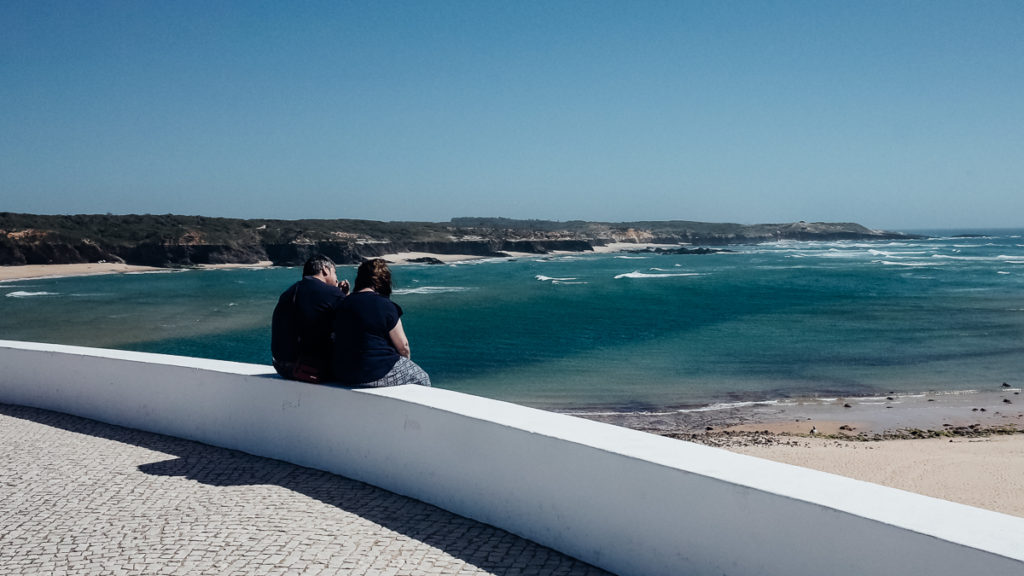
The truth is that I initially thought of spending the first night in Faro. I haven’t been to the Algarve region before, which initially sounded tempting. But after reading a bit about Faro and seeing some images, I decided to skip it. It looked like a mass tourism destination, and that’s always a dealbreaker for me. The winter was tough, and I’ve been looking forward to some quiet days in front of the Atlantic Ocean.
Why I’m writing all this? Well, if you have a long flight to Faro (mine from Berlin was almost 4 hours), you might want to relax the first day and get a good sleep. Otherwise, you’ll have to drive for a few hours after your flight. If you feel tired or flying from the USA or Asia to Portugal, Faro can accommodate you for a night. If you think it’s no problem to drive for two hours, then better leave Faro behind and head towards the mainland, towards Alentejo.
I preferred the latter. Straight after picking up the car at the airport, I left Faro behind. The first place that I chose to stay was Zambujeira do Mar. This was, so to say, my introduction to Alentejo. After a four-hour flight from Berlin to Faro, I was glad to observe Alentejo’s relaxing cork oak landscape. Variations of green and yellow accompanied me until Zambujeira do Mar. It was, as I said, an almost two-hour drive.
The first days: Zambujeira do Mar

Even though it was the first place I visited in Alentejo, Zambujeira do Mar became my favorite. Due to the beautiful landscape, the ride from Faro seemed faster. However, it was not a long ride, so I didn’t feel tired when I arrived at Zambujeira do Mar.
Apart from the landscape, in Zambujeira do Mar, I stayed in one of the most original hotels I have ever stayed in. It’s actually a barn that Rodrigo, the owner, has turned into a small family-run hotel. Don’t imagine something fancy: it still feels like a barn in the middle of a vast field. You can even listen to the Atlantic Ocean on windy days, which is just 4-5 kilometers away. The Monte do Papa Leguas barn is a place that I still daydream about. I loved waking up there, and I enjoyed the homemade breakfast. Ah, I wish I could stay there longer. But I promised myself that I’d spend the biggest part of my stay in Zambujeira do Mar whenever I return to Alentejo.
And here’s why.
Alentejo road trip travel guide: What to do in Zambujeira do Mar
Zambujeira do Mar is a small settlement with just a bunch of basic facilities. Do not expect anything fancy on this side of Portugal. Here, it’s all about simple life. You can enjoy the sea, good food, and kindness, lots of kindness. The truth is that Zambujeira do Mar can be the perfect base to explore the region around it. As it is centrally located in the so-called Alentejo Litoral, you have countless options for excursions and day trips. I stayed four days at Monte do Papa Leguas barn, and from there, I explored the famous Costa Alentejana. That’s actually the coastal road next to the Atlantic Ocean.
For people enjoying being at the beach and swimming, Zambujeira do Mar offers several great beaches nearby. For the laziest ones, there is one at the edge of the settlement. It’s a magnificent spot with great views. However, I found the nearby Alteirinhos beach to be the nicest. It’s a short fifteen-minute walk from the main Zambujeira do Mar beach, and when you reach Alteirinhos beach, you must climb down some steps. Nothing hard, though. It’s a vast beach, and there’s space for everyone.
Don’t miss the chance to enjoy the small bays all along the coast. Keep in mind (more on that later) that the ocean water is always cold and the streams very powerful.
Apart from swimming, there’s also the Rota Vicentina. Every Alentejo travel guide should include this marvelous hiking trail, which runs along the coast. Sooner or later, you’ll come across the Cabo Sardão, one of the region’s highlights. It’s a really scenic spot, and the cliffs are vertical. That’s the only maritime spot in Europe where storks are nesting. I have written more about Cabo Sardão, so check my resources at the end of this post.
Food in and around Zambujeira do Mar
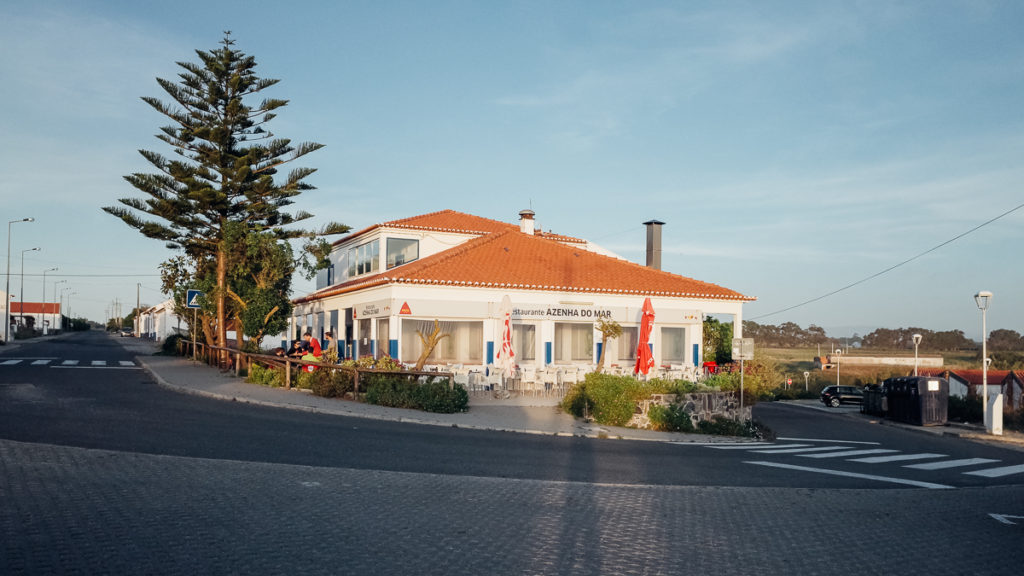
Even though I like trying different food daily, in Zambujeira do Mar, I kept eating in only two places. Since you are so close to the Atlantic Ocean, I recommend you eat as much fish as possible during your journey to Alentejo. It’s delicious, and the locals are masters in preparing it.
Rodrigo, the small hotel owner, recommended both restaurants, but to this day, I can’t decide which one is better. The first one is called Restaurante a Barca-Tranquitanas, and it’s a short ten-minute drive from Zambujeira do Mar. The location is prime, straight in front of the Ocean. If you sit outside, you will hear the Atlantic Ocean. As for the fish, well, it’s delicious. Plus, the service is fantastic as well.
The second restaurant is a bit more far away. The A Azenha do Mar is really a tavern at the end of the world. When you arrive in front of it, you think you have reached the end of the whole continent. The people running it are polite and gentle, and the food is fantastic. So if you visit Zambujeira do Mar, do yourself a favor and try to eat at both places.
Exploring the area around Zambujeira do Mar: Vila Nova de Milfontes
I wasn’t impressed by Vila Nova de Milfontes. Compared to Zambujeira do Mar, it felt more like a resort town. The houses are all similar, and everything seems neatly organized. For the raw landscape I saw during my road trip to Alentejo, I found the Vila Nova de Milfontes rather disappointing. I did spend half a day there, and I swam at sea. I’d say it’s okay for a shortstop, but I would carry on driving otherwise.
If you’d like to swim in a more beautiful spot, I’d suggest Praia de Nossa Senhora, a lovely beach, after leaving Zambujeira do Mar and heading towards Vila Nova de Milfontes. Equally impressive but less raw is also the Beach Carvalhal.
Exploring the mainland: Evora, Elvas & Estremoz

After leaving the Vicentine Coast behind, the road will lead you to Central Alentejo. That’s the landlocked area of Alentejo, and you won’t be close to the ocean anymore. However, this will also give you a better overview of how life unfolds in Alentejo. I know that it might not sound that tempting to be in Portugal and stay away from the coast, but trust me, it deserves it. You will see numerous villages and small towns that are full of history. Plus, some of them are very beautiful.
So, after leaving Zambuheira do Mar, you will start crossing a cluster of smaller and bigger settlements. Cercal and Alvelade definitely deserve a stop. You can walk a bit around and buy some provisions. After driving for a couple of hours, you will realize Central Alentejo is not rougher than Alentejo Litoral. It’s as if the region keeps its character intact, whether you are on the mainland or the coast.
You will finally reach the three most important towns of Central Alentejo: Evora, Estremoz, and Elvas. Each one of them deserves a visit.
Alentejo road trip & travel guide: Evora
Evora is the largest settlement of Alentejo, and you can even call it a proper city. With a population of 55,000 people, Evora hosts -in other words- one out of ten inhabitants of the whole region. While you will have a city feeling in Evora, don’t expect something intense. Evora keeps the sleepiness of the region intact, and it’s one of the most beautiful places you can visit in the Iberian peninsula. In Evora, you’ll feel like being in the region’s administrative center, but, as I said, don’t expect a busy life. The fact that there’s a university in Evora will give you a sense of liveliness because of the students. Not that far from Évora, you can also visit Vila Viçosa, which has a colorful Ducal Palace.
You can expect the prices to be slightly higher than in the other towns, but you won’t kill your budget. If you love cathedrals, whitewash, and cobblestone streets, look no further: Évora is for you. From all the places I’ve seen in Alentejo in Evora, I felt that there were also tourists for the first time. Most of them were interested in religious tourism, and I think everyone visiting Evora should stop at the Chapel of Bones (Portuguese: Capela dos Ossos). That’s one of the most bizarre places I’ve seen in Europe: skulls and bones are everywhere on the walls (I’ll link to my travelogue from Evora later on).
For a guided tour in Evora, please check here. That’s probably the easiest way to make the most of your stopover in Evora.
Estremoz
Estremoz is definitely a return to the more original feeling of Alentejo. A sleepy town with white walls and a siesta that paralyzes everything. I arrived at 3 p.m. and could hardly spot a single soul walking. Instead, I was greeted by a bunch of stray dogs, and it took me a while to make them stop barking. I must admit that it was unpleasant. But apart from that, Estremoz is split into two sections: the castle and the city outside the walls.
The castle of Estremoz is genuinely picturesque, and you should definitely walk around it. On the other hand, the new town is less impressive, but at least there’s a bit more life. Overall, I’d say to spend a couple of hours in Estremoz, but I wouldn’t consider spending the night there.
Elvas: one of my bases for the road trip to Alentejo
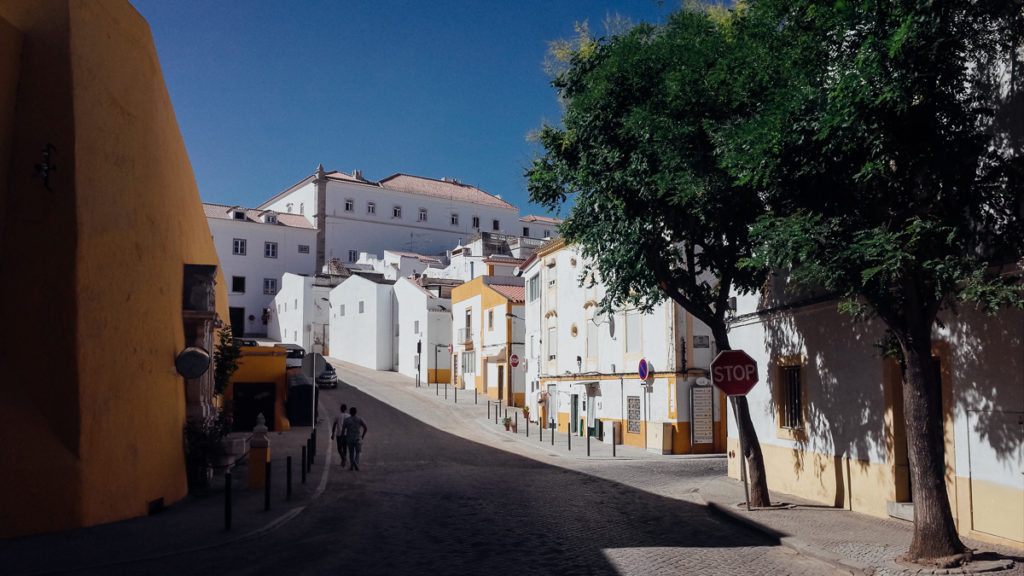
I used Elvas as my base for exploring Central Alentejo, and I don’t regret it. Elvas is a beautiful city built entirely within a castle. This sort of castle-cities is definitely charming, and I would also suggest staying there. Apart from that, Elvas is a typical example of an Alentejo city: everything seems too white, the roads are cobblestone, and the atmosphere is laid-back. I preferred to spend my days in Central Alentejo in Elvas and use it as a base for exploring the region.
I rented a very spacious room in Elvas, and I think I had the best view of the town. At night, I’d stay till late on the big veranda and write. Or go to O Gremio for the biggest Gin Tonic of all time.
There’s also a local tour if you are interested -you can check the tour around Elvas here. Elvas has the most impressive aqueduct you’ve seen, and the guided tour will give you all the necessary information.
The hidden gem of Alentejo: Evoramonte
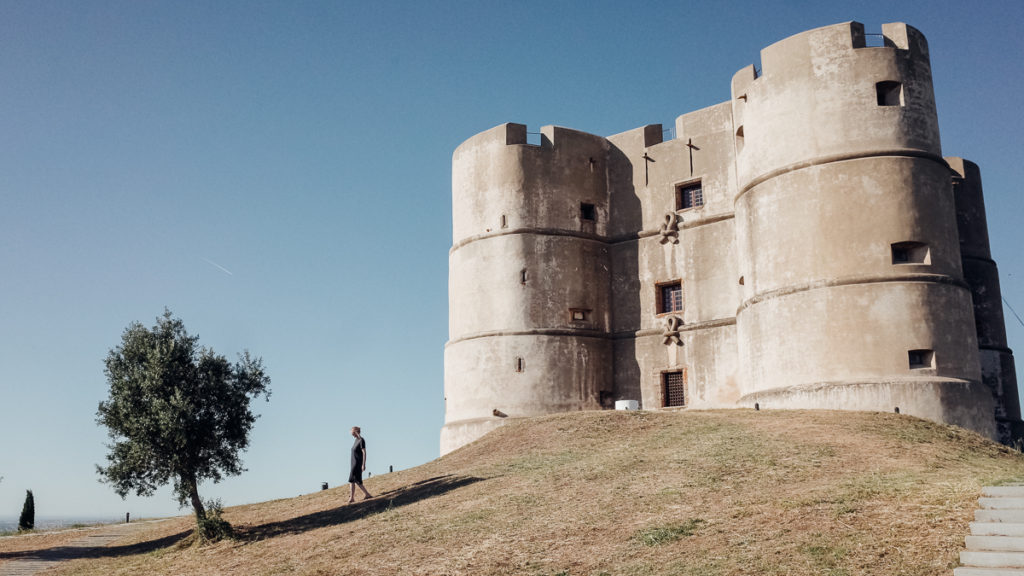
Now, there are always bits and pieces that one can miss while traveling abroad. But honestly, I would never forgive myself if I’d missed Evoramonte. That’s the absolute gem of the region, a definite highlight of the whole Alentejo. I was so impressed that I thought of adding it at the beginning of this long Alentejo travel guide. I didn’t do it because I wanted it to be a reward for the ones who made it all the way to this point of the Alentejo travel guide.
Evoramonte is a tiny settlement built on a hill. Apart from the fantastic view, Evoramonte features a castle at the top of that hill. The landscape is terrific, and I think the 2-3 hours I spent in the village were among the highlights of my road trip to Alentejo. To make it even better, there’s also a cafe with a view of the whole region, and you can also spend the night in the village’s only hotel. Honestly, visiting Evoramonte and the castle is one of the best things to do in Alentejo, so don’t miss it.
If you are not on a tight schedule, I can only suggest you stay one night at The Place at Evoramonte. It’s next to the castle, and the view is breathtaking.
Alentejo travel guide: The other side of Costa Alentejana
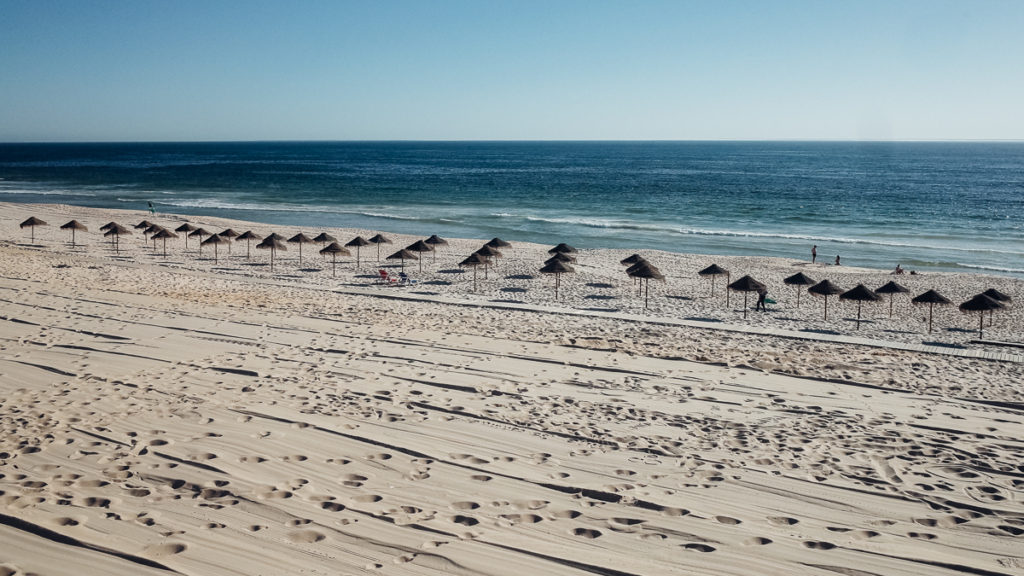
So, now it’s time to leave Central Alentejo and head back to the coast. After a long winter in Berlin, I missed the sea a lot, so I thought of spending the last days of my Alentejo road trip in front of the Atlantic Ocean. This side of Alentejo is somehow the area between the socialist-spirited Grândola and the sleepy Comporta.
The truth is that the closer you move to Lisbon, the more urbanized the landscape becomes. That’s not, of course, happening only in Lisbon, but everywhere in the world. But here’s the thing: while the scenery is still beautiful, nature is tamed. That said, even though that’s still the Costa Alentejana, there’s a significant difference compared to the area around Zambujeira do Mar.
The smaller settlements: Montemor-o-Novo & Arraiolos
The locals told me that these small towns on the way to the coast look similar. So I stopped for a couple of hours at Montemor-o-Novo, and I don’t regret it. It’s a beautiful small settlement, with interesting architecture but not so much life. I found a cafe called Pedrista and spent some time there on a hot afternoon. After leaving it behind and while driving towards the coast, I remember crossing a cluster of villages named after saints: São Romão, São Cristóvão, Santa Susana, and Santa Catarina.
The main settlements: Grândola & Comporta
Don’t expect anything like Évora, but these are the main settlements on this side of Alentejo. While every Alentejo travel guide has an obligatory stop in them, the truth is that I found them rather dull. I stopped in both of them, and I walked around. Grândola was more interesting because of its past, but I’m not sure they really deserve a longer stay. If you are more into urban exploration, then a stop in every town might be something for you.
However, I believe that Alentejo is all about nature and its rustic touch; therefore, I think it’s better to explore the smaller settlements. Check both cities for yourself; you might find something interesting. As I said, I just stopped for a couple of hours in each one of them.
Brejinho de Água
Talking about smaller settlements, I decided to base myself on the village of Brejinho de Água. I thought I would find the Zambujeira do Mar of northern Alentejo here. But as I already wrote, the landscape feels smoother here. No matter what, I had a pleasant accommodation called Monte do Brejinho de Água, run by Nuno, who was a great host. It was also located in a vast field, and the Atlantic Ocean was not that far away. From there, I explored the places I mentioned above and spent time at the nearby beaches.
The beaches were beautiful: long sandy seaside and a cold sea. I swam at Praia do Pego, Praia Pinheirinho, Praia da Raposa, and Praia dos Brejos (Praia, apparently, stands for the beach). Unfortunately, due to a mistake in my navigation, I lost the chance to swim at Praia da Galé – Fontainhas, and I ended up overlooking it from the middle of nowhere (I’ll link later to the story). The beach I enjoyed the most, though on this side of Alentejo, was Carvalhal: it was actually the only beach where the water wasn’t that cold.
Four days later, I left Brejinho de Água and drove towards Lisbon to catch a flight back to Berlin. After spending all these days in such a rural area (with the slight exception of Évora), it was a small shock to be back in a capital. I only saw Lisbon briefly this time, but it felt much bigger than it really is.
How many days do you need for a road trip to Alentejo?

I’m always a big fan of the reply, “the more days, the better.” While Alentejo is not a vast region, it will still require several hours of driving. The highways are in good condition, but the smaller streets are full of turns, and they’ll challenge your driving skills a bit due to the potholes. But I know you are here for a reply, so here it is: don’t plan a road trip to Alentejo if you don’t have at least 7 days. If you have less than a week, try to avoid adding too many places to your itinerary, or you’ll drive day and night.
If you’ve been following this blog for a while, you probably know that I’m a fan of slow traveling. That said, I like to have breathing space on my journeys, and I try to enjoy the places I visit and not consume them. Therefore, I believe that for a perfect road trip to Alentejo, you’ll need two weeks. I also spent two weeks in Alentejo, and I think I covered most of the region. Of course, I missed some places -for example, I didn’t visit Beja- and sometimes had to choose between two areas of interest. However, the two-week timeframe gave me enough time to relax and enjoy some days at the beach.
If you have more than two weeks, then it’s for sure that you can stop in even more places without driving that much. But I would say that the sweet spot is two weeks for a road trip to Alentejo.
How to split the time in Alentejo?
Well, in photography, there’s something called the rule of thirds. When it comes to an Alentejo travel guide, it’s only fair to say that you split the total number of days into three, equal to the subregions. For example, if you have 12 days on a road trip to Alentejo, I suggest spending 4 days in every area mentioned above. Of course, you can always improvise, and the split-into-three rule applies if you want to see almost everything.
If, for example, you have no interest in Central Alentejo, you can just drive all along the coast of Alentejo. However, I find it a pity not to see places like Evora or Evoramonte.
Alentejo travel guide: Accommodation, budget & more

In this section, you’ll find answers to the most common questions. Apart from the best things to do and see in Alentejo that I mentioned above, there are also a bunch of questions that I think it’s better to reply to them in the travel guide. If you have any further questions, please leave them as a comment, and I’ll try to respond to them in this section.
Where to stay in Alentejo?
This will largely depend on what you’d like to do in Alentejo. For example, if you’d like to see the most original and untamed version of Alentejo, head to the south, in the area around Zambujeira do Mar. I think that it doesn’t get more authentic than that. So, if you enjoy staying in nature with just a few people around you and many fantastic beaches, look no further. As I wrote earlier, I was thrilled at the Monte do Papa Leguas barn. Whenever I revisit Alentejo, I’ll stay in this little barn.
On the other hand, if beach days or very rural settlements aren’t for you, I suggest staying at Evora. While Evora is not a huge city, it has several places of interest, is rich in history, and has some nightlife (and life in general compared to the rest of the region.) From Evora, you can also drive to other places like Estremoz and Evoramonte and get a good impression of Central Alentejo.
In general, I would say that Alentejo is more about its rural areas and less about its towns. If I were you, I’d definitely try to stay somewhere like Zambujeira do Mar. Use the map below to navigate through the different areas and accommodation options in Alentejo.
When it’s the best time to visit Alentejo?
Alentejo can be hot already from April. I traveled to Alentejo in mid-May, and there were days that I couldn’t stop sweating. If my memory serves me right, the day I left Elvas and drove back to the coast, it was 35 C at 11 a.m. And that was mid-May! Although the sea won’t be warm, the days in Alentejo tend to be very hot. The fact that the houses are next to each other and most towns have cobblestone streets won’t make things better. I suspect it might be too hot at the peak of the summer (July-August) to have a proper vacation, especially if you are not close to the beach.
Since I am a Greek, I know how hot summertime can be in Southern Europe. Therefore, I suggest you skip July and August and travel to Alentejo either in May or June or from September onward. If you can only visit Alentejo in July or August, make sure to be close to the sea most days. And I think I don’t have to mention having sunscreen with you, right?
How to budget for Alentejo? Is it expensive?
I always found the prices in Portugal to be moderate. Alentejo is not an exception, and to be honest, I found it much cheaper than Lisbon. That’s no surprise, of course, but still, I wouldn’t take it for granted. After all, it’s an area that travelers start to discover. As is always the case for accommodation, there’s a wide range of accommodation options.
That said, it depends mainly on your travel style and how much money you’ll spend. However, you can easily find double rooms that won’t cost you more than 50-60 euros per night. If you avoid the high season, you can even find significantly cheaper hotels and rooms.
Food is not expensive either. You won’t pay more than 15-20 euros anywhere, even if you choose to eat fish. On the rare occasion you order something special, the bill might go up to 25 euros. I never paid more than 20 euros in a restaurant. And I must say that the house wine was fantastic everywhere and kept the costs down.
For example, after a long day at the beach, I stopped at a local cafe at Zambujeira do Mar. I ordered an espresso and then thought of drinking a glass of red wine. Half an hour later, I asked for the bill. I couldn’t believe that the man asked for 2,50 euros for both. As a destination off the beaten path, Alentejo remains cheap.
So, if you are traveling solo to Alentejo, I would say you can have everything for approximately 100 euros per day. This includes accommodation, food, a light snack, and water for the day. The cost can go down to 70 euros per person for two people traveling, given that you share accommodation.
Is it safe to swim in Alentejo?
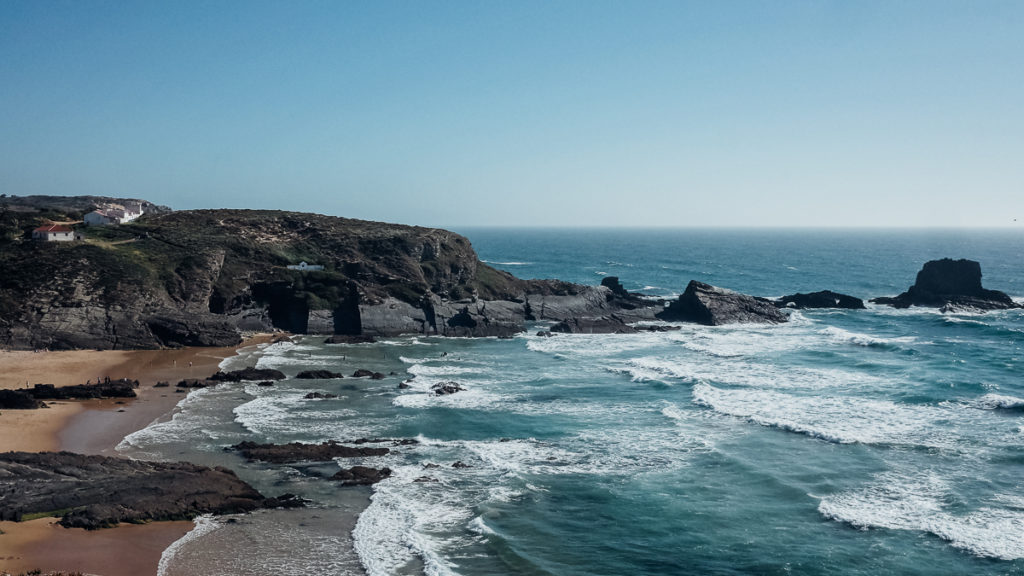
Of course. It is absolutely safe to swim in Alentejo. However, you have to take a couple of things into consideration. First of all, that’s not the Mediterranean Sea anymore; it’s the Atlantic Ocean. And that makes a huge difference. If you are used to swimming in Greece or Italy, I can assure you that it’s different. The waves can be really high, and the currents are strong. That said, if you are not experienced, avoid swimming far away from the shore. The streams of the Atlantic can carry you away in no time.
Second, the water is really cold. Even though it was more than 30 C in the shadow by mid-May, I remember myself shivering for half an hour at the beach after swimming. Don’t underestimate how cold the water in the ocean can be, and if you start feeling cold, get out. Don’t risk getting sick and ruining your vacation.
Other than that, the beaches in Portugal are sandy and occupy kilometers along the coast. Don’t miss the chance to swim in the Atlantic Ocean, but as I said, take care of the waves and the currents.
What to eat in Alentejo?
Well, Alentejo lies straight into the Ocean, so eating fish sounds right. In fact, I ate fish every night during my journey to Alentejo. Also, the local wine is delicious, and if you enjoy wine tours, you can also take one in Alentejo. Some other specialties of the region are sheep’s cheese, black pork -known as Porco Preto– and wild mushrooms.
How far is Alentejo from Faro?
From the airport at Faro, it takes approximately one and a half hours to reach the first villages of Alentejo. If you’re heading towards Zambujeira do Mar, calculate almost two hours by car.
How far is Alentejo from Lisbon?
From Lisbon to Evora, the biggest city in Alentejo, it’s approximately one hour and thirty minutes. Once again, it depends on where in Alentejo you’re going. For example, from Lisbon to Comporta, it takes one hour and twenty minutes by car.
What are the must-sees in Alentejo?
The places you should definitely see in Alentejo are:
- Zambujeira do Mar
- Cabo Sardao
- Evora
- Elvas
- Evoramonte
Is Alentejo worth visiting?
Absolutely. If you want to experience a traditional Portuguese atmosphere, eat delicious food, and swim in the Atlantic Ocean, Alentejo is a must.
How to pronounce Alentejo?
I know that’s an odd one, but I heard people pronouncing the “j” as “ch.” The correct way to pronounce Alentejo is A-le-nte-zu.
Alentejo road trip & travel guide: my resources

I have written three long travelogues covering every region of Alentejo. You can read them together as a road trip report from this beautiful region in Portugal. The travelogues include more photos and my impressions and stories. I’m adding them as extra material for your road trip to Alentejo.
- The end of a continent. That’s the first part of my travelogue, covering the area around Zambujeira do Mar. You can read it here.
- From Evora to Elvas. I’m moving towards the region’s mainland in the second part of the travelogue. Elvas, Evora, and Evoramonte are among the highlights here. You can read the second part here.
- Back to the coast. Last but not least, on the final part of the road trip to Alentejo, I return to the coast for a few days before leaving Portugal. You can read the third part here.
- *Bonus*. You can see some extra photos from my journey through Alentejo here.
Alentejo Road Trip: Final thoughts

Alentejo is Portugal’s hidden gem. It’s one of the last undiscovered regions of Europe, and this won’t probably last forever. A road trip to Alentejo will expose you to nature’s beauty and the Atlantic Ocean’s power. Add on top the laid-back attitude of the locals and delicious food, and you’ll have the full image.
Most of you probably already know how much I love the south of Europe. Writing an Alentejo travel guide somehow brought back some beautiful memories. Despite always daydreaming of places I haven’t visited before, Alentejo holds a special place in my dreams. I think it won’t be that long before I revisit it. If you haven’t been to Alentejo so far and feel like having a fantastic road trip in Europe, with long sandy beaches and tall waves, look no further. Alentejo is waiting for you.
More travel guides: 7 days in Greece, Where to travel solo in Europe
Pin it for later

Sharing is caring. Please share the ultimate Alentejo travel guide with your friends.
Last Updated on June 26, 2024 by George Pavlopoulos



Alentejo looks like it would be a great place to visit. I have visited Lagos and a few other small beach towns in Portugal and found them incredible. I really love Portugal and the fish dinners are the best!
Hey John, I can only agree: Alentejo is one of the most authentic regions in Europe. Food is an integral part of daily life in Portugal and especially fish is delicious. I haven’t been to Lagos so far, but I think I’ll visit it soon. Take care!
Lagos is a fantastic place. The town is so charming and the beaches with the coves are mind blowing. You won’t regret going there. I want to go there again. It’s a dream beach destination. From what I’ve seen I think all of the beaches in Portugal are amazing and doing a road trip is definitely the way to go. I caught buses and trains over 7 days which was easy enough but having a car would have been the best. Also make sure you visit Sintra. It has amazing palaces and beautiful gardens, and be sure to check out the Palace of Quinta da Regaleira. Wow!!!!!!!!!!!!
Thanks, John, I will!